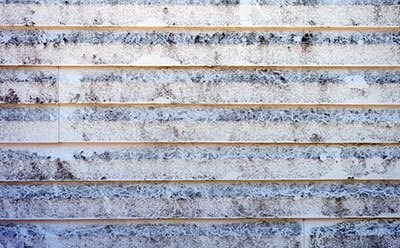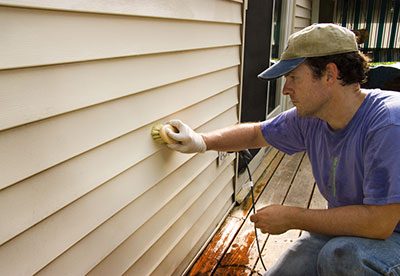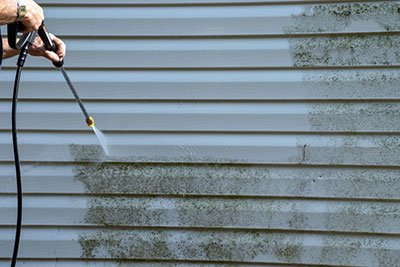Mold and mildew growth on vinyl fence systems is a common problem many homeowners face, but it doesn’t have to be that way! With the right preventative measures, you can make sure your vinyl fence system will stay looking clean and fresh throughout the year.
We’ll discuss the best methods for preventing mold and mildew growth on your vinyl fence system. So you never have to worry about an unsightly buildup of green or black discoloration again.
Let’s get started by taking a look at why having a good cleaning routine is essential for keeping away any unwanted guests from your beautiful fencing!
Take away key points:
- You can use various tools – white vinegar, dish soap, laundry detergent with warm water, and similar mixtures with mineral spirits to keep your fencing optimal and clean
- PVC fencing is a low, almost maintenance-free system, so you can use pressure washers and similar units to wash away the mold and keep your fencing clean
- There are different methods to keep your PVC fencing clean and free of mold, so learn all techniques for the best results
Table of Contents
- Best vinyl fence maintenance guide to preventing mold!
- What causes mold on vinyl fences?
- Preventing mold on vinyl fencing
- Removing mold from a white vinyl fence
- Removing green mold from your vinyl fence
- What can you spray to remove mold from your vinyl fencing?
- Other effective solutions to remove mold from vinyl fencing
- Will a garden hose prevent mold on the vinyl fencing?
- Other vinyl fence maintenance tips
- FAQs
- Final words
Best vinyl fence maintenance guide to preventing mold!
If you have a vinyl fence and need to protect it from mold spores, mildew, and similar fence damage, you can take a look at our guide. You will find different eco-friendly ways and non-toxic tips to remove mold and clean fence systems.
What causes mold on vinyl fences?

When excess moisture enters the vinyl, it creates a favorable environment for molding, algae feed, tree sap, and moisture seeping. This is especially common in areas with high humidity or inadequate fence maintenance.
Moreover, there are other reasons for molding, including incorrect installation and insufficient preparation before painting or sealing a maintenance-free fence. Keeping the grass clippings on your vinyl or wooden fences can also cause mold.
Preventing mold on vinyl fencing
Preventing mold on your vinyl fence goes beyond just avoiding damage to your belongings. It is crucial to avoid health problems that come with mold growth.
By taking preventative measures, you can be at ease knowing that your room is clean and free of any mold or insect infestations.
Step 1: Clean the vinyl fence regularly
It’s important to keep the area around you clean by regularly removing any dirt or debris that accumulates. Maintaining a weekly cleaning schedule for your vinyl fence can help prevent mold and unwanted pests from entering your home.
In case of water buildup near ventilation openings like windows, replace the dirty filter promptly. It’s advisable to wear protective clothing and a mask during this task to avoid any health hazards.
Step 2: Ensure there is no moisture on the vinyl fence at all
In case of a stain on your vinyl fence caused by a leak or water source, it’s important to remove the affected area from the wall and eliminate any moisture to prevent mold growth.
If removal is not possible, covering the area with plastic sheets temporarily is recommended. Be sure to change the sheets regularly to avoid them becoming moldy. If high humidity is the issue, open doors and windows to facilitate the escape of excess moisture and maintain dry air on the fence and other surfaces.
Step 3: Use plastic sheets to cover damaged areas
To prevent mold on your vinyl fence walls caused by stains from a leak or water source, it’s best to remove the affected areas. If that’s not immediately possible, covering the affected area with plastic sheets can provide a temporary solution. Regularly changing the sheets is important to prevent mold and insect infestation.
Step 4: Apply a protective coating
To prevent mold on vinyl fences, consider using specialized protective agents to cover damaged areas. This seals off the spots and protects them from water and other sources of decay.
It’s important to use a non-toxic coating to ensure your health and to test the product on an inconspicuous spot as it may affect the color of your fence. If mold has already developed on your vinyl fence, it’s crucial to remove it as soon as possible using a soft brush or a product formulated for this purpose.
For a particularly resilient mold, stronger solutions may be necessary. However, it’s important to proceed with caution and avoid damaging the wall coverings in the process.
You can use the garden hose and a pump sprayer with a spray nozzle to ensure the pressure washing cleans the fence and prevents dirt build-up.
Removing mold from a white vinyl fence

Removing mold from your white vinyl fence can be a challenging task. If possible, seeking professional help is recommended. However, if you choose to remove the mold on your own, there are important factors to consider.
Follow the steps below to keep your white vinyl fences optimal:
– Wear gloves and work in a well-ventilated area. Scrub the affected area of your new fence with a solution of bleach or vinegar and a gallon of water.
– Remove any sealant layers and stains to keep the fence clean.
– Apply the whitening cleaning solution generously to the moldy area, avoiding the use of water or a wet sponge.
– Let the magic eraser sit for 5 minutes before rinsing off with clean water.
– After the white vinyl fencing has completely dried, apply a new sealant for cleaning power.
– Once the magic eraser is dry, you can paint your fence if desired.
However, it is important to note that if you lack experience in removing mold from vinyl fences, it’s recommended to seek professional assistance.
Removing green mold from your vinyl fence
To remove green mold from a vinyl fence installation, it’s important to understand its cause. Typically, green mold appears as discoloration on the fence caused by moisture buildup, which commonly occurs during the spring months or due to condensation buildup.
Cleaning and drying the fence thoroughly with warm soapy water and a soft scrub brush is the first step in preventing future mold growth. Avoid using bleach-based products that may harm the fence material.
If any green mold remains, it can be removed using rubbing alcohol or bleach-soaked blotting paper applied with a soft bristle brush. also, wear rubber gloves so as not to let your hands touch the bleach solution.
Be careful not to leave the bleach solution or vinegar solution on the fence for too long, as it may cause damage to the fencing system.
Rinse the area with water after removing the mold to prevent it from spreading and hardening into a permanent stain. Immediate treatment is essential as mold growth can become challenging and time-consuming to remove.
What can you spray to remove mold from your vinyl fencing?
You can make a mold spray again for the fence damage.
To create a homemade mold spray for vinyl siding, mix one gallon of water, half a cup of salt, and a quarter cup of household bleach. Apply the mixture evenly onto the vinyl siding, ensuring all PVC fence areas are covered.
Allow the solution to dry before allowing children or animals near the PVC fence. If you have metal gutters or downspouts, spray them with the organic material solution as well to prevent mold growth on those surfaces.
Other effective solutions to remove mold from vinyl fencing
You don’t need expensive store-bought cleaners and many vinyl restoration products to effectively clean your white vinyl fence.
Here are some DIY, more low-maintenance options:
– Baking soda and water: Mix these in a bucket to create a paste. Scrub the paste onto the fence with a brush and let it sit for 10 minutes on any stubborn stains. Rinse your entire fence with water when done.
– Vinegar and water: Mix distilled vinegar with water in a bucket to get your vinyl fence cleaner. Scrub the fence with the mixture and rinse when done to keep the vinyl fence clean.
– Wet & Forget Moss: This commercial cleaning solution works well and is easy to use with pressure washer equipment. However, try the DIY options first before investing in a commercial vinyl fence cleaner and similar vinyl restoration products. Always rinse your fence with water when you’re done cleaning it.
Will a garden hose prevent mold on the vinyl fencing?
Spraying water from a garden hose can help remove moss or mildew from the fence surface. To prevent mold, it is recommended to use a white vinegar solution or bleach mixed with water to clean the fence thoroughly.
For tough stains, a power wash from a pressure washer and a high-pressure nozzle can also be effective to protect fences from stains, mildew, and other oxidation and sun damage.
Other vinyl fence maintenance tips

Here are some maintenance tips to keep your vinyl fence in top shape:
– Regular cleaning: Give your vinyl fence a quick rinse with a garden hose to remove any dirt and debris. For more stubborn areas, use a gentle soap and water mixture to wipe them away.
– Mildew removal: Practice good lawn care to reduce the instances of mildew and algae on your vinyl fence. If needed, use a mild bleach cleaner with a soft brush to remove any spots.
– Annual inspection: Take the time to inspect your vinyl fence for any damage or lose parts. Fixing any issues now can save you time and money in the future.
– Situational checks: Check your fence after any major weather events, such as storms or heavy snowfall. Clear any debris that may have accumulated on your fence to prevent damage.
FAQs
How do you protect vinyl fencing?
The best way to protect your vinyl fencing is to follow the steps below:
– Wash the vinyl fence regularly with the pressure washer.
– Remove all traces of mildew and mold.
– Cut any overhanging tree branches, grass, and other plants ruining your construction.
– Regularly inspect the fences and fix mistakes immediately.
– Don’t place gravel and dirt on the vinyl fence.
– Fix other damage parts immediately.
Is it OK to use bleach on the vinyl fence?
You should not use bleach on the vinyl fencing, as it could degrade and dry out the vinyl surface.
Why your fence turns green causes and fixes?
If your vinyl or wood fences turn green, it means algae mildew, and mold are growing on them. So you must clean them instantly.
How to keep mold from growing on a vinyl fence?
You can apply different protection costing types and make your mixtures to apply on the fence. You can use a spray bottle or a pressure washer to apply these solutions on the fence.
Final words
There are several ways to protect your vinyl fence from mold. It is important to keep the fence clean and use products to help prevent the growth of mold. Also, regularly inspect the fence for any signs of moisture or water build-up so its structure stays strong and doesn’t develop any other issues in the future.
Remember, early detection is key! With periodic inspections and preventative solutions, you can rest assured that you’re doing everything possible to keep white walkers at bay and enjoy your vinyl fence for years to come!
